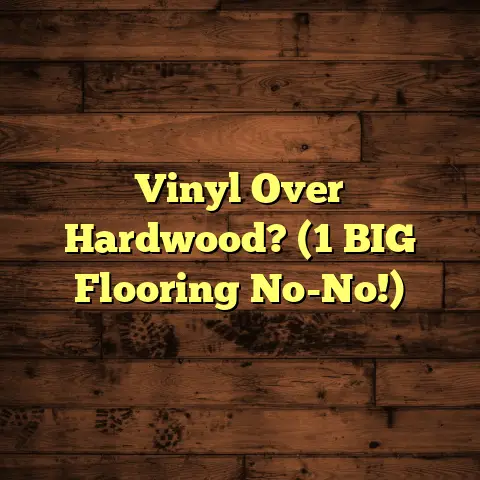Laminate Box Count? Find Out! (2 Min Calc!)
Ever started a flooring project only to realize you’re short a few boxes? Trust me, I’ve been there. It’s frustrating, time-consuming, and can throw your whole schedule off.
That’s why getting your laminate box count right before you even head to the store is crucial. Think of it as your secret weapon against project delays, wasted money, and unnecessary stress.
Accurate box counting means you buy the right amount of flooring, avoid those annoying mid-project supply runs, and ensure a consistent look throughout your space.
So, let’s dive in and unlock the secrets to nailing that laminate box count!
Section 1: Understanding Laminate Flooring
What is Laminate Flooring?
Laminate flooring is like the chameleon of the flooring world. It’s designed to mimic the look of hardwood, stone, or even tile, but it’s made from a completely different process.
Essentially, it’s a multi-layered synthetic flooring product fused together through a lamination process. Typically, you’ll find these layers:
-
Wear Layer: This is the top layer, a transparent coating that protects against scratches, stains, and fading.
-
Decorative Layer: This is where the magic happens. A high-resolution photographic image gives the laminate its realistic wood, stone, or tile appearance.
-
Core Board: Usually made of high-density fiberboard (HDF) or medium-density fiberboard (MDF), this layer provides stability and impact resistance.
-
Backing Layer: The bottom layer provides a moisture barrier and helps balance the floor.
Why choose laminate? Well, it’s known for being:
- Durable: Resists scratches and dents better than some hardwoods.
- Affordable: Generally less expensive than hardwood, stone, or tile.
- Easy to Install: Many laminate floors feature click-lock systems, making DIY installation a breeze.
I’ve seen homeowners transform entire rooms over a weekend with laminate, and the results can be stunning.
Types of Laminate Flooring
Not all laminate is created equal. You’ll find variations in thickness, style, and texture. And these differences can influence your box count, believe it or not.
-
Thickness: Laminate flooring typically ranges from 6mm to 12mm. Thicker planks often feel more solid underfoot and can offer better sound insulation.
-
Style: The decorative layer offers endless possibilities. You can find laminate that mimics everything from rustic oak to sleek slate.
-
Texture: Some laminates have a smooth, glossy finish, while others have an embossed texture that mimics the grain of real wood.
For example, a thicker laminate might come in fewer planks per box, which means you’ll need more boxes to cover the same area compared to a thinner laminate.
Pro Tip: Always check the square footage covered per box before you start calculating. It’s usually printed right on the box.
Section 2: Why Box Count Matters
The Importance of Accurate Box Counting
Okay, so why is this box count thing such a big deal?
Imagine this: You’re halfway through installing your new laminate floor, feeling great, and then…bam! You run out of flooring.
Now you’re stuck making an emergency trip to the store, hoping they still have the same batch (color variations can happen between batches, trust me!).
Or worse, they’re out of stock, and your project grinds to a halt. That’s the kind of headache accurate box counting helps you avoid.
But it’s not just about avoiding delays. It’s also about:
- Saving Money: Over-ordering means wasted materials and wasted money.
- Ensuring Consistency: Getting the right amount upfront ensures a uniform look throughout your floor.
- Reducing Stress: Knowing you have enough material allows you to focus on the installation process.
Common Misconceptions
Let’s bust a few myths about laminate box counts:
- “Extra Boxes Are Always Necessary”: While it’s good to have a little extra for mistakes and future repairs, overdoing it leads to unnecessary waste.
- “Measuring is Too Complicated”: I’m going to show you a simple, straightforward method that anyone can use.
- “The Store Will Calculate it For Me”: While store employees can help, it’s always best to double-check their calculations yourself.
I’ve seen projects derailed by relying solely on someone else’s estimate, so take control and learn to do it yourself!
Section 3: How to Calculate Laminate Box Count
Alright, time for the main event! Here’s a step-by-step guide to calculating your laminate box count:
Step-by-Step Calculation Process
-
Measure the Room:
- Use a measuring tape to determine the length and width of the room in feet.
- If the room isn’t a perfect rectangle or square, divide it into smaller, more manageable shapes, calculate the area of each, and then add them together.
-
Calculate the Room’s Area:
-
Multiply the length by the width to get the area in square feet. Formula:
Area = Length x Width -
Determine the Square Footage Per Box:
-
Find this information on the laminate box itself. It will usually say something like “Covers X Square Feet.”
-
Calculate the Number of Boxes Needed:
-
Divide the total room area by the square footage covered per box. Formula:
Number of Boxes = Total Area / Square Feet Per Box -
Account for Waste:
-
Add a waste factor to account for cuts, mistakes, and odd-shaped areas. I typically recommend adding 10% for rectangular rooms and 15% for rooms with lots of angles or curves. Formula:
Waste Factor = Number of Boxes x Waste PercentageTotal Boxes Needed = Number of Boxes + Waste Factor -
Round Up:
-
Always round up to the nearest whole number. You can’t buy part of a box!
Tools and Equipment Needed
- Measuring Tape: A good quality measuring tape that extends at least 25 feet.
- Calculator: To crunch those numbers.
- Pencil and Paper: For jotting down measurements and calculations.
- Flooring Layout Diagram (Optional): If you’re planning a specific installation pattern, a diagram can help you visualize the layout and estimate waste more accurately.
Pro Tip: Measure twice, cut once (or in this case, calculate once). Accuracy is key!
Example Calculation
Let’s say you’re flooring a rectangular living room that measures 12 feet wide by 18 feet long.
- Room Area: 12 feet x 18 feet = 216 square feet
- Square Feet Per Box: Let’s assume your laminate covers 20 square feet per box.
- Number of Boxes Needed: 216 square feet / 20 square feet per box = 10.8 boxes
- Waste Factor: Let’s add a 10% waste factor:
- 8 boxes x 0.10 = 1.08 boxes
- Total Boxes Needed: 10.8 boxes + 1.08 boxes = 11.88 boxes
- Round Up: You’ll need to purchase 12 boxes of laminate.
See? It’s not rocket science!
Section 4: Factors Affecting Box Count
Room Shape and Size
The shape and size of your room can definitely throw a wrench in your calculations if you’re not careful.
Odd-shaped rooms (think L-shaped, or rooms with lots of angles) require more cuts, which means more waste.
For these rooms, I recommend:
- Breaking it Down: Divide the room into smaller, more manageable rectangles or squares.
- Calculating Each Section: Calculate the area of each section separately.
- Adding Them Up: Add the areas together to get the total room area.
- Increasing the Waste Factor: Bump up the waste factor to 15% or even 20% to be safe.
Waste Factor
The waste factor is your safety net. It accounts for all those little mistakes, awkward cuts, and unusable pieces that inevitably happen during installation.
As I mentioned earlier, I typically recommend:
- 10% Waste Factor: For simple, rectangular rooms.
- 15% Waste Factor: For rooms with a few angles or curves.
- 20% Waste Factor: For complex rooms with lots of angles, curves, or built-in features.
It’s always better to have a little extra than to come up short.
Installation Patterns
Believe it or not, the way you install your laminate can also affect the amount you need.
- Straight Lay: This is the most common and efficient pattern, with planks laid parallel to each other.
- Diagonal: Laying planks at a 45-degree angle adds visual interest but creates more waste.
- Herringbone: This classic pattern is beautiful but requires a lot of cuts and a higher waste factor.
If you’re planning a diagonal or herringbone pattern, be prepared to buy significantly more laminate to account for the extra waste.
I’ve seen homeowners underestimate the waste factor for these patterns and end up scrambling to buy more flooring mid-project. Don’t let that be you!
Section 5: Where to Buy Laminate Flooring
Retail vs. Online
So, you’ve got your box count figured out. Now, where do you actually buy the stuff?
You’ve basically got two options:
- Retail Stores: Big box stores like Home Depot and Lowe’s, as well as smaller, local flooring stores.
- Online Retailers: Websites like Wayfair, Amazon, and specialty flooring websites.
Here’s a quick rundown of the pros and cons:
Retail Stores:
- Pros:
- See and touch the flooring in person.
- Get expert advice from sales associates.
- Easy returns if you over-order.
- Cons:
- Potentially higher prices.
- Limited selection compared to online.
- Have to transport the flooring yourself.
Online Retailers:
- Pros:
- Wider selection.
- Potentially lower prices.
- Convenient delivery to your doorstep.
- Cons:
- Can’t see and touch the flooring before buying.
- Returns can be more complicated.
- Shipping costs can add up.
How to Choose the Right Supplier
Whether you’re buying online or in-store, it’s important to choose a reputable supplier. Look for:
- Positive Reviews: Check online reviews to see what other customers have to say about their experience.
- Clear Return Policies: Make sure the supplier has a clear and easy-to-understand return policy in case you need to return unused boxes.
- Product Guarantees: Look for suppliers that offer warranties or guarantees on their products.
- Good Customer Service: Choose a supplier that’s responsive and helpful if you have questions or concerns.
I’ve personally had good experiences with both big box stores and online retailers, but it’s always worth doing your research to find the best fit for your needs.
Section 6: Final Thoughts on Box Counting
Recap of Benefits
Let’s quickly recap why nailing that laminate box count is so important:
- Avoid Costly Delays: No more mid-project supply runs!
- Save Money: Avoid over-ordering and wasting materials.
- Ensure Consistency: Get a uniform look throughout your floor.
- Reduce Stress: Enjoy a smoother, more efficient installation process.
Call to Action
Now that you’re armed with this knowledge, I encourage you to grab your measuring tape, calculate your room’s area, and determine your laminate box count before you head to the store.
Trust me, this simple step will save you time, money, and a whole lot of frustration in the long run.
Conclusion
Understanding your laminate box count empowers you to take control of your flooring project and achieve professional-looking results.
Don’t be intimidated by the numbers. With a little bit of planning and the right tools, you can confidently calculate your box count and enjoy a stress-free installation process.
Now, go forth and conquer that flooring project! And if you have any questions or experiences to share, please leave a comment below. I’d love to hear from you!





